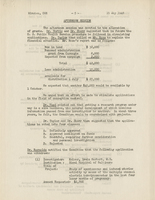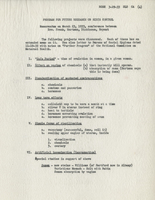National Committee on Maternal Health records, 1923-1959. B MS c78
Dublin Core
Title
National Committee on Maternal Health records, 1923-1959. B MS c78
Description
The Committee on Maternal Health was organized in New York City in 1923 by Robert L. Dickinson (1861-1950). After obtaining financial backing from several society women, Dickinson recruited physicians for the Committee to sponsor medical investigation of contraception, infertility, spontaneous abortion, and related issues. In 1930 "National" was added to its name, and the role of the Committee shifted to that of a clearing house for information on these issues; the Committee sponsored a series of monographs which were to serve as a handbook for doctors. The shift occurred because Dickinson was unsuccessful in obtaining sufficient data from hospitals for their research, and also failed to gain support from the medical profession for a clinical investigation through Margaret Sanger's Clinical Research Bureau. Dickinson, however, did associate himself with Sanger's Clinic in a private capacity after 1930, and was to serve as mediator through whom organized medicine made its peace with the birth control movement. Dickinson died in 1950. The Committee's office at the New York Academy of Medicine was closed in 1955, shortly before the resignation of the executive director. The Population Council was its successor organization; the data-gathering section remained in New York and the Council itself located in Princeton, N.J.
The collection records the activities of the earlier Committee on Maternal Health, and research, publications, and projects of the National Committee on Maternal Health (NCMH). Files contain agendas, minutes of executive committee and board of directors' meetings, annual reports, officer reports, and secretary's correspondence from 1923 to 1955. Also contains correspondence of executive directors, of Dickinson, and other committee members; correspondents include Margaret Sanger. Additional items include legal documents, financial statements and ledgers, reprints and bibliographies of NCMH publications, membership lists, and printed material on birth control. Events reflected in the records include a report of a 1924 visit to Sanger's Clinical Research Bureau by Dickinson and G. W. Kozmak; reports on the formation of Maternity Research Council; reports of round table discussions; and conference materials for the 1942 conference on the Medical Aspects of the Woman War Worker and the 1942 Conference on Abortion Problems. Also includes meeting minutes from the New York Obstetrical Society's Committee on Contraception (1923); and contract with National Research Council's Committee on Human Reproduction, with related correspondence.
The collection records the activities of the earlier Committee on Maternal Health, and research, publications, and projects of the National Committee on Maternal Health (NCMH). Files contain agendas, minutes of executive committee and board of directors' meetings, annual reports, officer reports, and secretary's correspondence from 1923 to 1955. Also contains correspondence of executive directors, of Dickinson, and other committee members; correspondents include Margaret Sanger. Additional items include legal documents, financial statements and ledgers, reprints and bibliographies of NCMH publications, membership lists, and printed material on birth control. Events reflected in the records include a report of a 1924 visit to Sanger's Clinical Research Bureau by Dickinson and G. W. Kozmak; reports on the formation of Maternity Research Council; reports of round table discussions; and conference materials for the 1942 conference on the Medical Aspects of the Woman War Worker and the 1942 Conference on Abortion Problems. Also includes meeting minutes from the New York Obstetrical Society's Committee on Contraception (1923); and contract with National Research Council's Committee on Human Reproduction, with related correspondence.
Collection Items
Survey of Medical Schools
Contraception, sterilization, sterility, and premarital hygiene were taught in less than half of American medical schools. The National Committee on Maternal Health surveyed medical schools to determine the state of human reproduction education in…
Meeting Minutes of the Committee on Human Reproduction
of the National Research Council
After World War II, Dickinson’s National Committee on Maternal Health and Planned Parenthood (the successor to Margaret Sanger’s American Birth Control League) asked the National Research Council to oversee a program of research in…
Are Present Birth Control Methods Satisfactory?
Another barrier, as Dickinson argued in a lecture he prepared for Margaret Sanger’s first world congress on birth control in 1934, was the lack of scientific knowledge of human reproduction.
Agencies Active in Study of Human Sex Problems
In 1929, Robert Latou Dickinson, MD visualized the relationships among organizations in this chart, created for the Committee on Maternal Health (CMH), an organization he established as a medical counterpart to Sanger’s Birth Control League.
Collection Tree
- Manuscripts and Archives
- National Committee on Maternal Health records, 1923-1959. B MS c78





